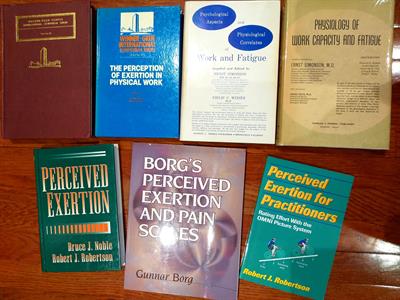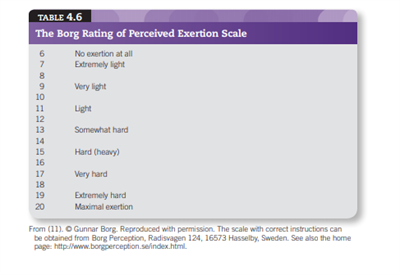Panteleimon Ekkekakis, Ph.D., FACSM, FNAK |
Feb.
18, 2020
 It is a rare achievement for a researcher's name to be recognized, and for a body of work to be appreciated, across all the diverse subdisciplines of exercise science. Gunnar Borg is one such name, and his research on perceived exertion is one such body of work. Gunnar Borg passed away earlier this month, at the age of 92, leaving behind an enormous, indelible legacy for our field.
It is a rare achievement for a researcher's name to be recognized, and for a body of work to be appreciated, across all the diverse subdisciplines of exercise science. Gunnar Borg is one such name, and his research on perceived exertion is one such body of work. Gunnar Borg passed away earlier this month, at the age of 92, leaving behind an enormous, indelible legacy for our field.
The study of "psychophysics" predates the emergence of the discipline of psychology, probably because scholars always found its subject matter so fascinating. Psychophysics, as the term implies, is concerned with deciphering the shape of the relationship between the physical properties of stimuli that act upon our sensory receptors and the subjective perceptions or sensations that these stimuli generate. Examples include the relation between the intensity of light and the perception of brightness or the relation between weight and the perception of heaviness. The first substantive contributions in this field of study date to the 19th century and the work of the German mentor-apprentice duo of Ernst Heinrich Weber (1795-1878) and Gustav Theodor Fechner (1801-1887).
Although it was long suspected that the relation between the physical properties of sensory stimuli and the associated perceptions is nonlinear, the idea that one changes as a power function of the other was revived and formalized by Harvard experimental psychologist Stanley Smith Stevens (1906-1973). In a classic 1957 paper published in the Psychological Review, entitled "On the psychophysical law," Stevens wrote that "the sensation ψ is proportional to the stimulus S raised to a power n." Thus, his famous "power law" states that ψ = kSn, where ψ is the magnitude of the sensation evoked by the stimulus, S is the physical magnitude of the stimulus, n is an exponent that varies by the nature of the stimulus or the sensory modality, and k is a proportionality constant that depends on the units used.
Following this publication, numerous research articles by Stevens and others started appearing, aimed at determining the value of the exponent that characterized the curvature of the relation between various sensory stimuli and their associated perceptions (e.g., loudness, brightness, cold, warmth, time duration). In 1959, Joseph Stevens and Joel Mack from Harvard published "Scales of apparent force" in the Journal of Experimental Psychology, wherein they applied the "power law" to explain earlier frustrating observations that, when participants were asked to exert, on a hand dynamometer, forces twice as great or one-half as great as a previous "standard" force, they failed to double or halve the physical magnitude of the standard. Approaching the problem from the perspective of the power law, Stevens and Mack reported that, indeed, the perceived force of the handgrip grew as a power function of the actual force exerted on the hand dynamometer, with an exponent of 1.7.
The previous year, in the spring of 1958, in Sweden, Gunnar Borg was teaching psychology at the medical school in Umeå, while his colleague Hans Dahlström was teaching physiology and directing the laboratory of clinical physiology. Borg later recounted that Dahlström was frustrated by the fact that his patients seemed to exaggerate declines in their work capacity (e.g., saying that they felt their endurance had declined by 50%, whereas physiological testing was showing changes that were half, or even less, of what the patients were reporting). Although the initial suspicion was that such discrepancies were the result of deliberate attempts to deceive (e.g., to gain insurance or retirement benefits), it soon became clear that this was a reliable perceptual phenomenon. And so, Borg and Dahlström designed the first studies to investigate perceptions of physical effort and the sensation of pedaling resistance on the cycle ergometer.
During the 1960s and 1970s, Borg pioneered the application of the power law to the study of the perception of physical exertion associated with strenuous whole-body exercise. Borg credits the serendipitous advent of research-grade ergometers in the mid-1950s (a field in which Sweden has been a world leader) as being instrumental in this research. On the basis of this work, he proposed his own version of the power law, R = a + c(S‑b)n, where R is the magnitude of the perceptual response, S is the stimulus intensity, a and b are constants indicating the starting point of the function, c is a proportionality constant, and n is the exponent (estimated as 1.6, close to the 1.7 reported by Stevens and Mack). The direct outgrowth of these investigations was the development of the Rating of Perceived Exertion and the Category Ratio-10 scales. The 6-20 scale, in particular, became very popular because ratings were designed to increase linearly with exercise intensity, and the numerical anchors were intended to correspond approximately to heart rates from 60 to 200 beats per minute. As these scales, and their many translations, found their way into more cardiac rehabilitation clinics, gymnasia, stadia, schools and military training camps, the name Borg became recognizable around the world.
Starting in 1967, Borg made several trips to the United States to collaborate with exercise-science researchers, including Bruce Noble, Kent Pandolf, Robert Robertson, Enzo Cafarelli, Ellsworth Buskirk, James Skinner, Oded Bar‑Or, William Morgan, and others. The first-ever symposium dedicated to the topic of perceived exertion was organized by Bruce Noble at the 1972 meeting of the American College of Sports Medicine in Philadelphia. The papers that were presented there were subsequently published in the Summer 1973 issue of Medicine and Science in Sports and Exercise (Volume 5, Issue 2). RPE was first recommended as a guide in monitoring and regulating exercise intensity in the third edition of the ACSM Guidelines for Exercise Testing and Prescription in 1986. It remains as a recommended adjunct method of prescribing and monitoring exercise intensity until the current (tenth) edition of the Guidelines. Arguably, the inclusion of RPE in the ACSM Guidelines made the scale an integral component of responsible exercise practice across the globe over the past four decades.
 Dr. Borg knew, and tried to correct, several misconceptions surrounding the construct of perceived exertion and the rating scales he introduced. For example, he cautioned not to take the presumed correspondence between a rating on his 6-20 RPE scale and heart rate "too literally" because "the meaning of a certain heart rate value as an indicator of strain depends upon age, type of exercise, environment, anxiety, and other factors." He also addressed concerns among clinicians that discrepancies between ratings of perceived exertion and heart rate may indicate lack of validity or practical value. He wrote that "neither a single RPE value nor a heart rate measure may be used alone as an accurate indicator of 'dangerous strain.' They complement each other." But perhaps his greatest pet peeve was the Cartesian divide. He wrote critically of a physiologist who declared that "he had not been interested in any psychological evaluations, since he was only interested in the physical strain of the subject." Borg's own view on this subject is captured in this aphorism: "Studying fatigue and exertion only from a physiological perspective is as impossible as dealing with color, emotion or motivation in primarily physical or only physiological terms. That is, exertion and fatigue are states with both physiological and psychological aspects."
Dr. Borg knew, and tried to correct, several misconceptions surrounding the construct of perceived exertion and the rating scales he introduced. For example, he cautioned not to take the presumed correspondence between a rating on his 6-20 RPE scale and heart rate "too literally" because "the meaning of a certain heart rate value as an indicator of strain depends upon age, type of exercise, environment, anxiety, and other factors." He also addressed concerns among clinicians that discrepancies between ratings of perceived exertion and heart rate may indicate lack of validity or practical value. He wrote that "neither a single RPE value nor a heart rate measure may be used alone as an accurate indicator of 'dangerous strain.' They complement each other." But perhaps his greatest pet peeve was the Cartesian divide. He wrote critically of a physiologist who declared that "he had not been interested in any psychological evaluations, since he was only interested in the physical strain of the subject." Borg's own view on this subject is captured in this aphorism: "Studying fatigue and exertion only from a physiological perspective is as impossible as dealing with color, emotion or motivation in primarily physical or only physiological terms. That is, exertion and fatigue are states with both physiological and psychological aspects."
Gunnar Borg left us his profound and insightful theoretical work, a voluminous, innovative, and systematic line of empirical research that extends over decades, several measures that can be found everywhere exercise scientists work, and, perhaps more importantly, his pleas to reject our disciplinary blinders and instead look at exercise, the subject of our great science, in all of its captivating complexity. Rest in peace, Gunnar.
The 1998 book entitled "Borg's Perceived Exertion and Pain Scales" (Champaign, IL: Human Kinetics) can be downloaded here.
Copies of the original Borg Scales for research and clinical purposes can be obtained here.
 Panteleimon Ekkekakis, Ph.D., FACSM, FNAK, is a professor of exercise psychology at Iowa State University, and a Fellow of the American College of Sports Medicine and the National Academy of Kinesiology.
Panteleimon Ekkekakis, Ph.D., FACSM, FNAK, is a professor of exercise psychology at Iowa State University, and a Fellow of the American College of Sports Medicine and the National Academy of Kinesiology.